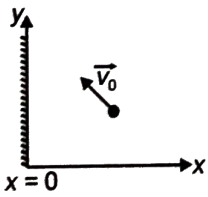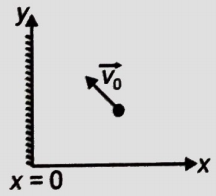Select the correct option.
(1) The velocity of light is constant in all media
(2) A convex lens always forms a real image
(3) If the aperture of the lens is halved then image size will be halved
(4) The ray optics is applicable when the size of the obstacle is more than the wavelength of light
सही विकल्प का चयन कीजिए
(1) प्रकाश का वेग सभी माध्यमों में नियत रहता है
(2) एक उत्तल लेंस हमेशा एक वास्तविक प्रतिबिंब बनाता है
(3) यदि लेंस का द्वारक आधा किया जाता है, तो प्रतिबिंब का आकार आधा हो जाएगा
(4) किरण प्रकाशिकी तब लागू की जाती है जब अवरोध का आकार, प्रकाश की तरंगदैर्ध्य से अधिक होता है
A white beam of light can deviate without dispersion by
1. using two suitable glass prisms placed in the same sense
2. using two suitable glass prisms placed in the opposite sense
3. Using a suitable glass prism
4. None of these
प्रकाश की एक श्वेत किरणपुंज बिना विक्षेपण के निम्न द्वारा विचलन कर सकती है
1. समान तरीके से रखे गए दो उपयुक्त काँच के प्रिज्मों का उपयोग करने पर
2. विपरीत तरीके से रखे गए दो उपयुक्त काँच के प्रिज्मों का उपयोग करने पर
3. एक उपयुक्त काँच के प्रिज्म का उपयोग करने पर
4. इनमें से कोई नहीं
If there is no emergent light through a prism of refracting angle , whatever may be the angle of incidence, then the minimum value of the refractive index of the material of the prism is
1. 2
2.
3. 1.5
4.
यदि अपवर्तन कोण वाले प्रिज्म के माध्यम से कोई प्रकाश निर्गत नहीं होता है, चाहे प्रिज्म का आपतन कोण कुछ भी हो, तो प्रिज्म के पदार्थ के अपवर्तनांक का न्यूनतम मान है:
1. 2
2.
3. 1.5
4.
A plane mirror is fixed in YZ-plane at x = 0. The velocity of a moving object is . The velocity of the image relative to a stationary observer will be:

1.
2.
3.
4.
एक समतल दर्पण YZ-तल में x = 0 पर स्थित है। गतिमान वस्तु का वेग है। स्थिर प्रेक्षक के सापेक्ष प्रतिबिंब का वेग होगा:

1.
2.
3.
4.
Two positions of the convex lens for which the image of the object is formed on the same screen are 40 cm and 80 cm from the object. The focal length of the lens is
1.
2.
3. 40 cm
4. 80 cm
उत्तल लेंस की दो स्थिति जिसके लिए वस्तु प्रतिबिम्ब समान पर्दे पर बनता है, वस्तु से 40 cm और 80 cm दूरी पर स्थित है। लेंस की फोकस दूरी ज्ञात कीजिए।
1.
2.
3. 40 cm
4. 80 cm
When an object is placed at 10 cm and 30 cm from a convex lens images obtained are of the same magnitude of magnification. The focal length of the lens maybe:
(1) 10 cm
(2) 15 cm
(3) 20 cm
(4) 25 cm
जब किसी वस्तु को उत्तल लेंस से 10 cm और 30 cm की दूरी पर रखा जाता है, तो समान आवर्धन के परिमाण का प्रतिबिंब प्राप्त होता है। लेंस की फोकस दूरी होनी चाहिए:
(1) 10 cm
(2) 15 cm
(3) 20 cm
(4) 25 cm
A major breakthrough in the studies of cells came with the development of electron microscope. This is because:
1. the resolution power of the electron microscope is much higher than that of the light microscope
2. the resolving power of the electron microscope is 200-350 nm compared to 0.1-0.2 nm for the light microsope
3. electron beam can pass through thick materials, whereas light microscopy requires thin sections
4. the electron microscope is more powerful than the light microscope as it uses a beam of electrons which has wavelength much longer than that of photons
इलेक्ट्रॉन सूक्ष्मदर्शी के विकास के साथ कोशिकाओं के अध्ययन में एक बड़ी सफलता सामने आई है। यह किस कारण है:
1. इलेक्ट्रॉन सूक्ष्मदर्शी की विभेदन क्षमता, प्रकाश सूक्ष्मदर्शी की तुलना में बहुत अधिक होती है।
2. प्रकाश सूक्ष्मदर्शी के लिए 0.1-0.2 की तुलना में इलेक्ट्रॉन सूक्ष्मदर्शी की विभेदन क्षमता 200-350 nm है।
3. इलेक्ट्रॉन किरण-पुंज मोटे पदार्थों से गुजर सकती है, जबकि प्रकाश सूक्ष्मदर्शी को पतले अंशों की आवश्यकता होती है।
4. इलेक्ट्रॉन सूक्ष्मदर्शी प्रकाश सूक्ष्मदर्शी की तुलना में अधिक प्रभावशाली है क्योंकि यह इलेक्ट्रॉनों की किरण-पुंज का उपयोग करता है, जिनकी तरंगदैर्घ्य फोटॉन की तुलना में अधिक होती है।
A lens having focal length f and aperature of diameter d forms an image of intensity I. Aperture of diameter in central region of lens is covered by a black paper. Focal length of lens and intensity of image now will be respectively
(a) f and (b)
(c) f and (d)
एक लेंस जिसकी फोकस दूरी f और द्वारक का व्यास d है, तीव्रता I का प्रतिबिम्ब निर्मित करता है। लेंस के मध्य क्षेत्र में, द्वारक का व्यास एक काले रंग के पेपर से ढका गया है। लेंस की फोकस दूरी और प्रतिबिम्ब की तीव्रता अब क्रमशः होगी:
(a) f और (b)
(c) f और (d)
A ray of light travels from an optically denser to rarer medium. The critical angle for the
two media is C. The maximum possible deviation of the ray will be
1.
2. 2C
3.
4.
एक प्रकाश-किरण प्रकाशिक सघन माध्यम से प्रकाशिक विरल माध्यम में गति करती है। दोनों माध्यमों के लिए क्रांतिक कोण C है। किरण का अधिकतम संभव विचलन कितना होगा?
1.
2. 2C
3.
4.
Figure shows a cubical room ABCD with the wall CD as a plane mirror. Each side of the
room is 3m. We place a camera at the midpoint of the wall AB. At what distance should
the camera be focussed to photograph an object placed at A
1. 1.5 m
2. 3 m
3. 6 m
4. More than 6 m
चित्र समतल दर्पण के रूप में दीवार CD के साथ एक घनाकार कमरा ABCD दिखाता है। कमरे की प्रत्येक भुजा 3m है। हम दीवार AB के मध्य बिंदु पर एक कैमरा रखते हैं। A पर रखी एक वस्तु के प्रतिबिंब के निर्माण के लिए कैमरे को किस दूरी पर फोकस किया जाना चाहिए?
1. 1.5m
2. 3m
3. 6m
4. 6m से अधिक







